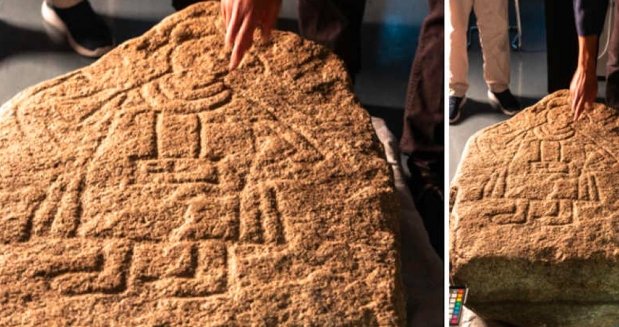In a remarkable discovery, a 12th-century picture stone has been unearthed in the village of Klotzow, located in the Vorpommern-Greifswald district of northern Germany. The stone, featuring a carved depiction of a Christian figure holding a cross, was found by homeowner Peter Wittenberg during construction work on his property. This rare find has garnered significant attention from historians and archaeologists, offering new insights into the Christianization of Northern Europe and the region’s medieval history.
The Discovery and Its Significance
The discovery of the picture stone was a stroke of luck for Peter Wittenberg, who stumbled upon the artifact while renovating his home. The stone, measuring approximately three feet in height and two feet in width, was found buried horizontally near the foundation of the house. Upon closer inspection, Wittenberg noticed the intricate carvings and immediately reported the find to local authorities.
Experts quickly identified the stone as a rare 12th-century picture stone, a type of artifact typically used during the Viking and Germanic periods. The carving on the stone depicts a standing man with a cross prominently displayed over his midsection, possibly representing a high-ranking Christian cleric. This discovery is particularly significant as it is the only known picture stone from the region featuring a figure holding a cross.
The stone’s unique iconography and historical context have made it an invaluable artifact for understanding the spread of Christianity in Northern Europe. The depiction of the cross and the figure’s attire suggest a connection to the Christianization efforts led by Bishop Otto of Bamberg, a key figure in the region’s religious history.
Historical Context and Analysis
The 12th century was a period of significant religious transformation in Northern Europe, marked by the efforts of missionaries like Bishop Otto of Bamberg. Otto, who undertook two major missionary journeys to the region, played a pivotal role in converting the local Slavic tribes to Christianity. The depiction on the picture stone is believed to represent Otto or a similar high-ranking cleric, highlighting the stone’s importance in the context of the Christianization of Pomerania.
The stone’s discovery in Klotzow adds a tangible piece to the historical puzzle of the region’s religious transformation. The presence of the cross, carved onto what appears to be a stole or pallium, further strengthens the connection to Otto, who received a pallium from the Pope in 1111. This vestment, a symbol of authority, underscores the significance of the figure depicted on the stone.

Archaeologists and historians are now working to analyze the stone in greater detail, hoping to uncover more information about its origins and the context in which it was created. The stone’s condition, despite centuries of burial, suggests it was well-crafted and carefully preserved, offering a rare glimpse into the artistic and religious practices of the time.
Broader Implications of the Find
The unearthing of the medieval picture stone has broader implications for the field of archaeology and our understanding of medieval history. This discovery not only adds to the historical record but also highlights the importance of local finds in uncovering the past. The stone’s unique features and historical context provide valuable insights into the spread of Christianity and the cultural dynamics of the region.
For the local community, the discovery has generated excitement and pride, drawing attention to the rich history of Klotzow and its surroundings. The find has also inspired renewed interest in the study of medieval artifacts, encouraging further exploration and research in the area. The involvement of experts in the analysis and preservation of the stone ensures that it will be studied and appreciated for years to come.
The story of the picture stone serves as a reminder of the potential for new and exciting discoveries in the field of archaeology. It underscores the importance of curiosity and exploration in uncovering the hidden stories of our past. As more information about the stone is revealed, it will undoubtedly contribute to our knowledge of medieval history and the Christianization of Northern Europe.












